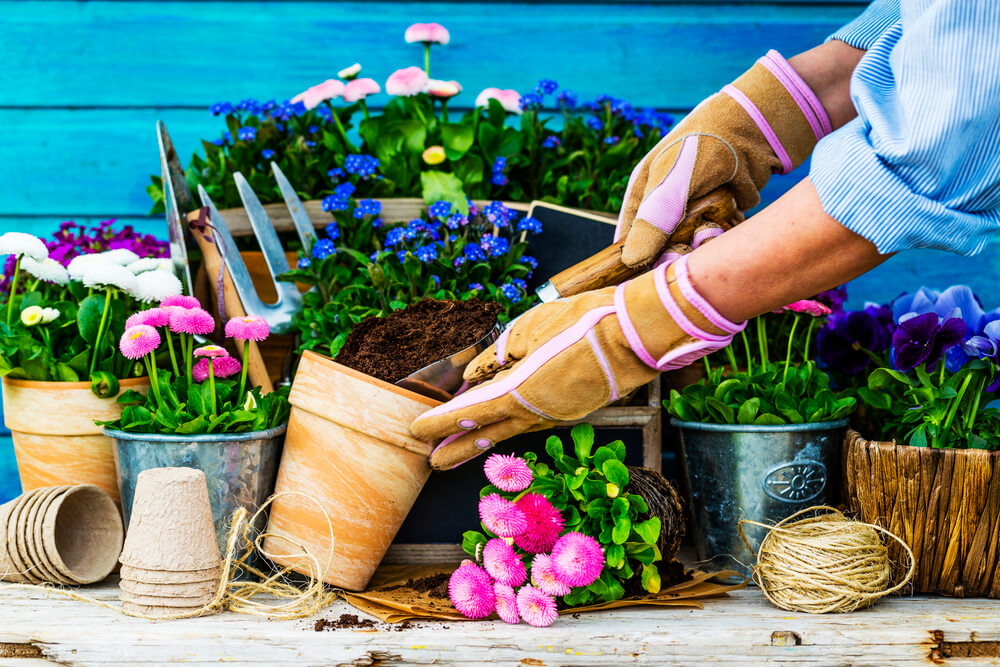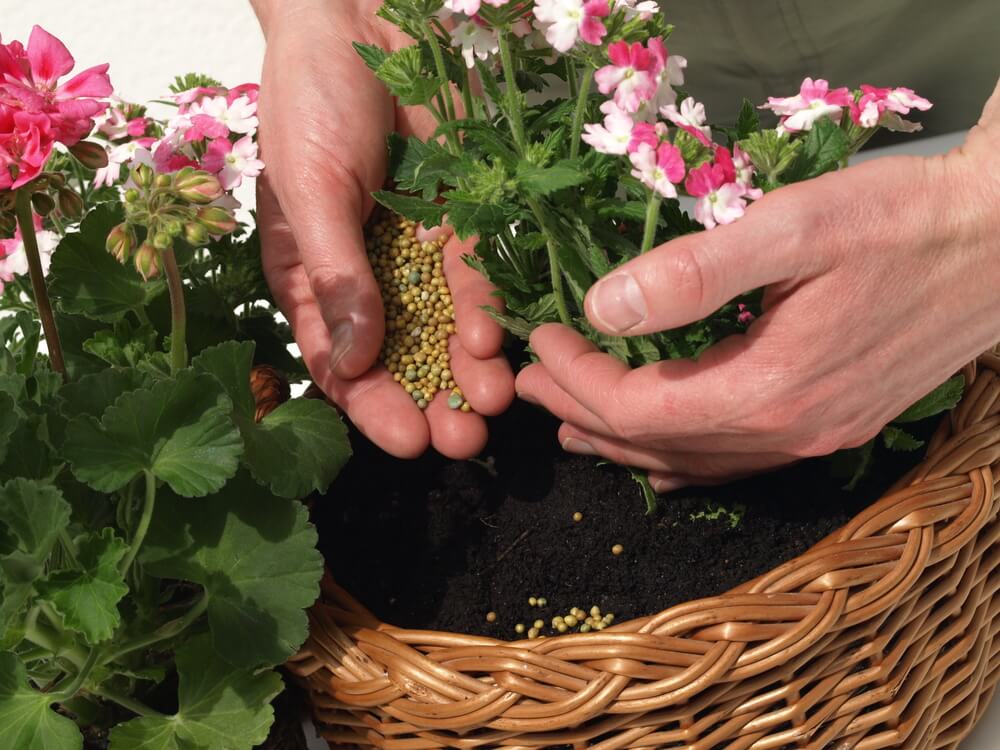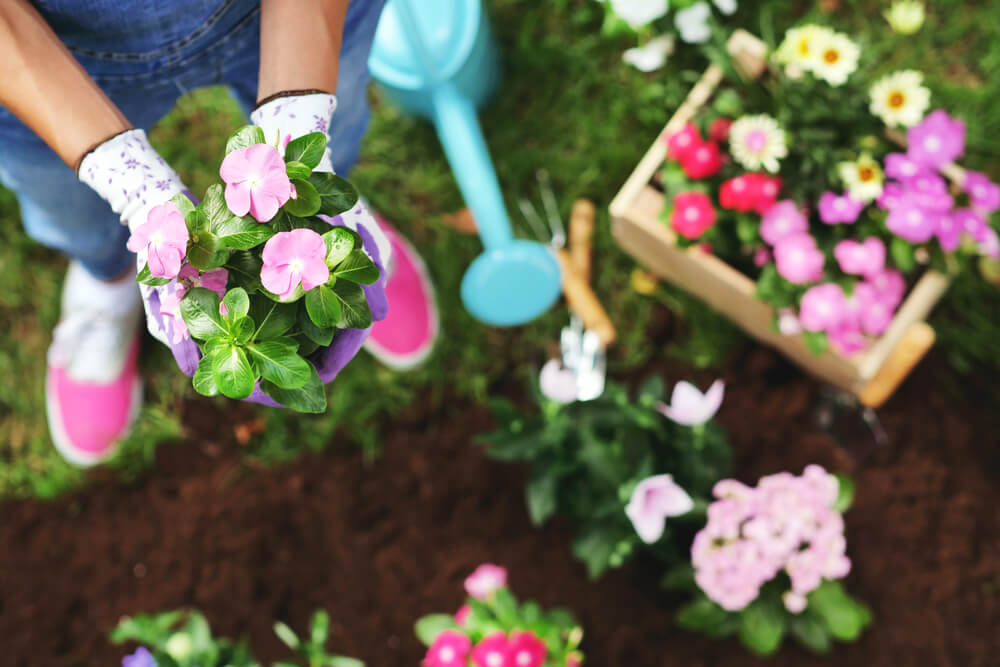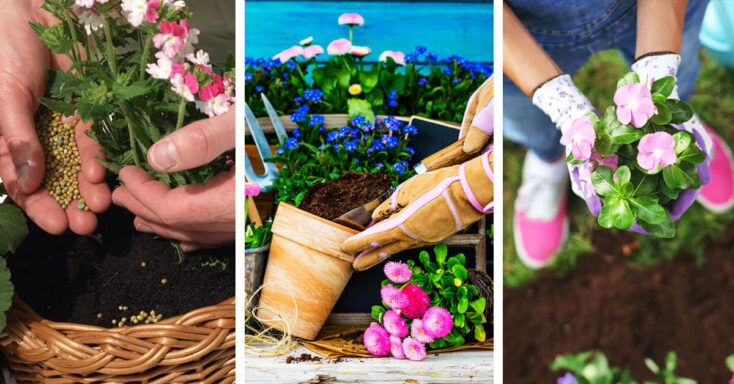While we might wish our gardens would grow without ongoing awareness and tending, it takes work to have a healthy garden. Annuals live but for a season. Perennials are competitive, seeking the same nutrients. The right fertilizer choice for both types of flowers supports their establishment.
Fertilizer Frenzy
If you want beautiful blossoms every year, success boils down to three things:
- Suitable Sunlight Levels
- Proper Watering
- Appropriate Nourishment
Looking specifically at nourishment, that’s the soil’s “job.” Soil contains essential ingredients plants need. The most important components are nitrogen, phosphorus, potassium, calcium, magnesium, and sulfur. Depletion of these natural nutrients after serious rains or when other plants are using everything up.
That’s when fertilizer comes to the forefront. But, you need to pick the right fertilizer to fill the gaps, paying attention to your plant’s needs.
Plants and animals have a commonality. They require specific things, so they grow strong and vigorous. In turn, you get a longer-lasting floral array. Fertilizer is an excellent amendment for your soil and comes in many ratios suited to different growing conditions.
Key Takeaways
- Different flowers often require different fertilizers. It helps to bundle those plants together that all have the same growing needs.
- There is too much of a good thing. Going heavy on fertilizer can burn the roots and kill beneficial microorganisms.
- Potassium can boost your flower’s roots, jumpstarting the season.
- The mantra of gardeners is, “Right plant, Right place,” so they get the nutrients they need.
7 Insights on Choosing Flower Fertilizer
Where it all Began: Looking through history, we find Egyptians, Babylonians, and Romans alike using things like manure on their farms. They probably observed how plants grew better where cows were wandering. Wood ash was another popular field treatment.
1. How Do the Ingredients in Fertilizer Foster Healthy Plants?
Did you ever wonder exactly how different soil nutrients help your flowers? Let’s take a look.
Calcium: Calcium supports root health, particularly for growing new roots. It also reinforces leaf development.
Magnesium: Magnesium is an integral ingredient for making green plant colors. It also helps with photosynthesis.
Nitrogen: Plant cells and proteins require nitrogen. This particular component can leave your soil quickly due to rain, meaning you’ll have to get a fertilizer offering nitrogen.
Phosphorus: This is a cornerstone for a maturing plant. It also acts as a conduit, bringing the energy from sunlight into the flowers.
Potassium: Potassium has several functions, including increasing a flower’s hardiness (disease resistance) and improving fruit growth if you have any small fruit bushes in your garden.
Sulfur: Sulfur boosts energy and adds both enzymes and proteins. You can thank sulfur for providing flavor to onions, garlic, and mustard.
“When tending a vast and beautiful garden, you have to plant many seeds, never knowing ahead of time which ones will germinate, which will produce the most glorious flowers, which will bear the sweetest fruit. A good gardener plants them all, tends and nurtures them, and wishes them well. Optimism is the best fertilizer.” – Kevin J. Anderson
2. Fertilizing by the Numbers
When you’re standing in front of the fertilizer section of the garden store, you’ll see different number combinations on the bags. What do they mean?
The first number is the percentage of nitrogen. The second number is the amount of phosphate, and the last is potash. The king of all fertilizers is the 10-10-10 mix, which is good for nearly any flower.
For the general health of your garden, a 3-1-2 mix, or 9-3-6, is ideal. To stimulate blooming, look for a fertilizer with a higher percentage of phosphate than nitrogen and potassium.

The Soil Test
Whether you’re starting a new garden, or a new gardening season, getting your soil tested alleviates a lot of headaches. You can purchase simple soil test kits at most garden centers. If you’re looking for more denied results, look around for a Cooperative Extension Office, or check with the professional garden services in your area.
The common concept was that fertilizer only dated to 2-3 BCE. New research suggests an application with ancient origins. Early farmers may have used manure in 8 BCE, perhaps earlier.
3. Flower Fertilizer Choice
If numbers weren’t confusing enough, there are different fertilizer options, including:
- Chemical Fertilizer: This product combines inorganic chemicals. You can find them at nearly any store with flowers and plants. They’re not terribly expensive. Over-application of chemical fertilizers causes burning. Signs of burning include white powder on top of the soil, wilting, and brown leaf tips.
- Complete Fertilizer: As the name implies, these mixtures focus on balanced nutrition for lush foliage and blossoms. These can be more costly than other types of amendments. The fixed ratio of ingredients may not suit all plants.
- Foliar Fertilizer: The plant’s leaves absorb these fertilizers. It can be inefficient for plants with waxy or hairy leaf surfaces. Potassium is one nutrient suitable for foliar efforts.
- Organic Fertilizer: This comes from organic matter. Organic fertilizers support a healthy immune system. It’s long-lasting and not toxic to beneficial insects. These mixtures do not act quickly.
- Simple Fertilizer: If you know what your soil needs, you can purchase only that nutrient-a simple fertilizer. Read your labels, as some are organic and some are chemical.
- Slow-Release Fertilizer: An ideal choice if you don’t want to fertilize regularly (or forget). The coating on this fertilizer releases the nutrients over a period of weeks.
Guano proved a unique and effective fertilizer in the Andes. Peru and Chili were the chief buyers of the export. Not to be outdone in novelty, in the early 1600s CE, people introduced fish as a fertilizer.
4. DYI: Fabricate Your Own Fertilizer
Believe it or not, there are several things in and around your house that you can turn into a healthy addition to your garden soil.
- Banana Peels: These won’t slip you up, but they’re certainly rich in potassium, something roses love.
- Coffee Grounds: For a fully awake garden… oh wait, that’s the gardener. You can sprinkle coffee grounds around rhododendrons, roses, and lots of other plants (plants that like acidic soil).
Tip: Check with coffee shops in your area. Several will keep bags of coffee grounds on hand, offering them for free.
- Eggshells: Your plants won’t have you walking on them! Eggshells lower acidity in the soil. They are also 93% calcium. Just clean them, crush them, and they’re ready for application.
- Epsom Salts: Dissolve the salts in water. In this form, you can use them as a foliar spray, or just water the plant directly. Nutrient: Magnesium.
- Grass Clippings: So long as you don’t treat your lawn, grass makes for great mulch to block out weeds. Main nutrient: Nitrogen.
- Leaves: Don’t toss all those fall leaves. They’re great for the soil because they attract earthworms. Till them into your soil.

When to Fertilize Your Flowers
Recheck your soil every year using a soil test. It’s a good foundation because the soil can change nutrient levels.
Your plants are ready for fertilizer when the first signs of growth come in spring. Feed them annually at the coolest part of the day (dawn-dusk). New plants are an exception. Wait until their roots have time to establish. Water the fertilizer so it disperses into the soil.
Some of your flowers are light feeders. Examples include butterfly weed, coneflower, aster, and beebalm. In some instances, if they get too much nitrogen, it may weaken stems. Also, any flowers grown in the shade won’t need as much fertilizer as those in the sun.
5. Applying Flower Fertilizer
If you have established gardens, gently rake fertilizer into damp soil, followed by normal watering. Should you have heavy mulch remaining from last season, try to move it back so the fertilizer doesn’t have to fight to get into the soil.
Beds with wildflowers are pretty hands-off. They don’t have high nutrient requirements. If you’re just planting, amend the bed. You can lightly fertilize them in spring.
Normally, you’d fertilize once a year, but long-lasting perennials may benefit from a second dose after 8 weeks after the initial one. Roses like fertilizer in May, June, and early July. Also, let nature guide you. When a bulb grows, sending up a green tip, that’s when you fertilize. So, you may fertilize parts of your flower garden at different times.
Hey, multitask. While you’re fertilizing, check soil drainage throughout the garden space. Your azaleas will thank you. They get grumpy when too wet.
The Power of Observation:Thousands of years ago, farmers paid close attention to signals from their land and herds. After all, there was no Farmer’s Almanac. They made their own. When the agriculturalist noticed everything grew better where their animals gathered regularly, the conclusion was pretty simple. The dung made the land fertile.
6. Over-Fertilizing Your Flower Garden

Even experienced gardeners may over-fertilize from time to time. Too much fertilizer blocks water intake, resulting in burns. One of the most important parts of your fertilizing regimen is remaining consistent. Don’t keep changing what you use. It increases the chance of over-fertilization because you are not familiar with the product. Plants get used to the goodies you give them. So when you use something different, it can cause plant shock.
Symptoms of over-fertilization include:
- Black-brown coloration in the roots
- Brown leaf margins
- Decreased growth
- Sudden plant growth (lanky plants)
- Wilted lower leaves
- Yellowing leaves
Really, the best protection against over-fertilization is “know before you grow.” Get that soil test, and follow the instructions on the bag of your chosen fertilizer.
“When a flower doesn’t bloom, you fix the environment in which it grows, not the flower.” – Alexander Den Heijer
7. Storage
At the end of a season, you may have leftover fertilizer. If you properly store those leftovers, it doesn’t really go “bad.” For example, liquid fertilizer can last up to 10 years (read the product information!).
- Retain the original bag or container and secure it with plastic wrap
- Store it in a cool, dry, dark space (garage?)
- Keep the fertilizer off the ground.
If it’s continually humid in your area, put the properly closed bag into a plastic container for a second layer of protection.
7 Tips about Flower Fertilize & Its Use
There is nothing more pleasant than walking among flowers or seeing them dance on the winds from your window. When you learn how to choose flower fertilizer, you’re helping ensure the health of your garden. Fertilizers can also promote bigger, longer-lasting blossoms. Just take care to follow the directions provided by the manufacturer.
If you suspect your soil may have issues, get a test or have it tested by a professional. This can ease a lot of heartache over dying or dead flowers.
Frequently Asked Questions About Flower Fertilizer
Which fertilizer is best for flowers?
The answer to this question depends on the soil’s composition and the needs of the flowers. Generally, you cannot go wrong with a 10-10-10 mixture.
How do I choose the best fertilizer for my plants?
If you’re just starting your garden, check the containers you purchased. Sometimes a little stick in the soil will tell you about fertilizing choices, along with sun and water preferences. Don’t be afraid to ask the garden department personnel, either. There is no “perfect” fertilizer because soil conditions change, and different plants may have dissimilar nutrient requirements.
Which nutrient encourages flowering?
Nitrogen is the plant’s partner for green, leafy growth. Phosphorus gives the flower energy for putting out impressive blossoms.



